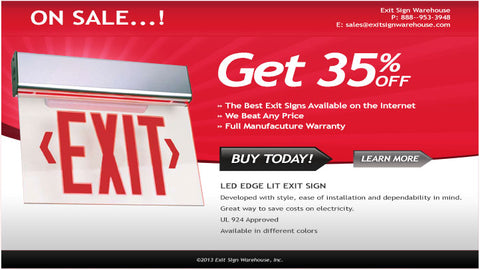Exit Sign Regulations - Requirements
 All Exits shall be marked by a readily visible sign. Exit Signs are required designation and exit access and should be located with such Size, Color, Contrast and Design as to be visible incase of an Emergency.
All Exits shall be marked by a readily visible sign. Exit Signs are required designation and exit access and should be located with such Size, Color, Contrast and Design as to be visible incase of an Emergency.Exit Sign Regulations and Requirements for your local area.
OSHA Regulation: Means of Egress
Exit signs must be clear of decorations, equipment which may impair visibility to means of an Exit. Access to exits must be marked by visible signs in all cases where the exit or way to reach it is not immediately visible to the occupants. Consisting with any door passage, or stairway which is neither an exit nor a way of exit access, and which is so located or arranged as to be likely to be mistaken for an exit, shall be identified by a sign reading "Not an Exit" or similar designation, or shall be identified by a sign indicating its destination; examples include "To Break Room," "Electrical Room," "Machine Room".
Exit Signage Requirements
An Exit sign, or similar designation, with an arrow indicating the directions, shall be placed in every location where the direction of travel to reach the nearest exit is not immediately apparent or as directed by local fire marshal.
Each of the signs marking exits should have the word "Exit" in legible letters no smaller than six inches high. The main stroke of the letter should be 3/4 inch wide. If the path to the nearest exit isn't obvious, an exit sign that includes an arrow directing the reader to the nearest exit will be required. 8 inch letters apply in some Boroughs of New York and City of Chicago. Please refer to local laws in depth Sign Regulations and requirements.
The requirements for placement, brightness and number of exit signs in a commercial building is governed by both OSHA, The NFPA, as well as other state and local regulations. We will define each of these organizations and note the applicable regulations.
The Occupational Safety and Health Administration, or OSHA, is responsible for ensuring safe and healthful work facilities for working employees. The NFPA, or National Fire Protection Association advocates global consensus standards and codes. Underwriters Laboratories is an organization devoted to product safety, and UL 924 is their agreed upon standard for Power Equipment as well as Emergency Lighting.
The general requirements for exits are set out by OSHA and the NFPA in 29 CFR 1910.35, which states that an exit is defined as an unobstructed path for exiting any place in a building to a public way. That egress is defined in three parts.
- Access: This is the part of the exit that is the entrance to the exit.
- Exit: This is the part of the exit that is separate from any other section or part of the building and offers a protected path of travel to the discharge.
- Discharge: This is the point where the exit meets the public way.
OSHA sets out that all exit routes should be lit well enough that any employee with normal vision will be able to see the route. 1910.37(b)(1) They also set out that every exit should be marked by a sign reading "Exit".

Illumination Requirements for Exit Signs
Exit signs must be properly illuminated by a reliable light source, with a minimum of 5 foot-candles on the illuminated surface. Ambient lights sources giving illumination to exit signs other than the Electrical Exit signs must have screens, discs, or lenses of not less than 25 square inches area made of translucent material to confirm Contrast.
The requirements for the illumination of exit signs are set out by the NFPA in their life safety code, or NFPA 101. It dictates that all signs should be lit under the following standards:
- Every sign required should be suitably illuminated via a reliable source of light. Externally, internally, and photo luminescent illuminated signs are all permissible.
- There must be at least 1.5 hrs. of emergency light if the building lighting fails.
- The provided emergency lighting should put out light that is at least an avg. of 1 foot-candle, and never less than .1 foot-candle. The regulation also sets out standards for the decline of the strength of light and uniformity ratio of that light.
- If a photo luminescent sign is used, a light must be provided to charge that sign so that if the lights go out, the sign will stay illuminated for at least 1.5 hours.
- Any signs with internal illumination should be listed and comply with the standards of UL 924.
In addition to these requirements, some state and local governments have created additional codes regulating the requirements of exit signs. For example, New York City mandates that any building taller than 75 feet should also have photo luminescent markings on any door that leads to an exit or exit stairs. California also sets out additional regulations in their labor code. Make sure you check your state and local government for any additional regulations that may apply to you.

